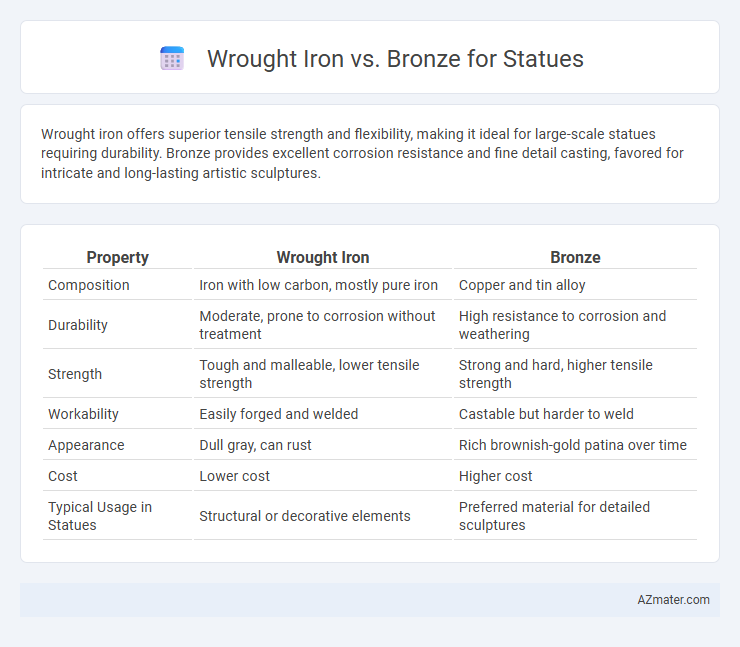Wrought iron offers superior tensile strength and flexibility, making it ideal for large-scale statues requiring durability. Bronze provides excellent corrosion resistance and fine detail casting, favored for intricate and long-lasting artistic sculptures.
Table of Comparison
| Property | Wrought Iron | Bronze |
|---|---|---|
| Composition | Iron with low carbon, mostly pure iron | Copper and tin alloy |
| Durability | Moderate, prone to corrosion without treatment | High resistance to corrosion and weathering |
| Strength | Tough and malleable, lower tensile strength | Strong and hard, higher tensile strength |
| Workability | Easily forged and welded | Castable but harder to weld |
| Appearance | Dull gray, can rust | Rich brownish-gold patina over time |
| Cost | Lower cost | Higher cost |
| Typical Usage in Statues | Structural or decorative elements | Preferred material for detailed sculptures |
Introduction to Wrought Iron and Bronze Statues
Wrought iron statues exhibit exceptional durability and intricate detailing due to their malleable yet strong iron composition, making them suitable for outdoor installations. Bronze statues, composed primarily of copper and tin, are renowned for their classic aesthetic, corrosion resistance, and ability to capture fine artistic details through the lost-wax casting process. Both materials offer unique benefits: wrought iron provides a rustic, industrial appeal while bronze delivers timeless elegance and longevity.
Historical Significance of Wrought Iron and Bronze
Wrought iron has been historically significant for its malleability and durability, enabling intricate detailing in statues since the Middle Ages, often symbolizing strength and industrial progress. Bronze, with roots dating back to ancient civilizations such as the Greeks and Romans, is renowned for its corrosion resistance and patina development, making it a preferred medium for timeless sculptures and public monuments. The enduring use of wrought iron and bronze reflects their distinct cultural and artistic values throughout history.
Physical Properties: Strength and Durability
Wrought iron exhibits high tensile strength and excellent malleability, making it resistant to cracking under stress, while its fibrous structure enhances durability against corrosion when properly maintained. Bronze, an alloy primarily of copper and tin, offers superior compressive strength and naturally develops a protective patina that significantly increases long-term resistance to weathering and oxidation. Both materials provide robust structural integrity, but bronze's enhanced corrosion resistance often makes it preferable for outdoor statues exposed to harsh environmental conditions.
Aesthetic Differences: Appearance and Finish
Wrought iron statues exhibit a rustic, textured surface with a dark, matte finish that emphasizes intricate craftsmanship and age-old techniques. Bronze statues offer a smooth, polished appearance with a rich, golden-brown patina that evolves over time, enhancing depth and warmth. The choice between wrought iron and bronze significantly impacts the visual appeal, with wrought iron highlighting rugged, industrial aesthetics and bronze providing a classic, elegant finish.
Cost Comparison: Wrought Iron vs Bronze
Wrought iron statues generally cost less than bronze due to the lower price of raw materials and simpler manufacturing processes. Bronze, an alloy primarily composed of copper and tin, carries a higher cost reflecting the expense of metal extraction and alloying, as well as more labor-intensive casting techniques. Maintenance expenses also differ; bronze develops a protective patina over time, reducing upkeep costs, whereas wrought iron may require more frequent treatments to prevent rust and corrosion.
Maintenance and Longevity of Statues
Wrought iron statues require regular maintenance to prevent rust and corrosion, including periodic cleaning and protective coatings, whereas bronze statues develop a natural patina that acts as a protective layer against environmental damage. Bronze offers superior longevity due to its corrosion resistance and low maintenance needs, often lasting several centuries with minimal upkeep. In contrast, wrought iron's susceptibility to oxidation necessitates more frequent interventions to preserve structural integrity and aesthetic quality.
Suitability for Outdoor and Indoor Displays
Wrought iron offers excellent durability and resistance to weather elements, making it highly suitable for outdoor statues exposed to rain, wind, and temperature changes. Bronze, known for its corrosion resistance and classic aesthetic, is ideal for both indoor and outdoor displays, aging beautifully with a patina that enhances its artistic value. For long-term outdoor exposure, bronze's low maintenance and toughness often surpass wrought iron, which may require periodic rust protection.
Environmental Impact and Sustainability
Wrought iron and bronze differ significantly in environmental impact and sustainability, with wrought iron being more environmentally friendly due to its simpler metallurgical process and higher recyclability. Bronze, an alloy primarily of copper and tin, requires mining of multiple metals, leading to greater ecological disturbance and energy consumption. Wrought iron's lower carbon footprint and ability to be recycled multiple times without loss of quality make it a more sustainable choice for statues.
Popular Examples of Wrought Iron and Bronze Statues
The Statue of Liberty's internal framework, designed by Gustave Eiffel, showcases wrought iron's strength in monumental sculpture, while the bronze statue of David by Michelangelo exemplifies bronze's enduring popularity for its detailed craftsmanship and weather resistance. Wrought iron statues like the intricate floral ironworks in Victorian garden sculptures highlight its malleability and durability in outdoor installations. Bronze statues, including the famed Charging Bull in New York City, emphasize the metal's capacity to capture fine details and its resilience to corrosion, making it a preferred choice for public art worldwide.
Choosing the Right Material for Your Statue
Wrought iron offers exceptional durability and a classic dark finish, making it ideal for large outdoor statues exposed to harsh weather conditions, while bronze provides superior corrosion resistance and a timeless, warm patina that enhances fine details over time. Choosing the right material depends on factors such as environmental exposure, desired aesthetic, and maintenance preferences, with wrought iron requiring more frequent upkeep to prevent rust and bronze offering low-maintenance longevity. Assessing the statue's location and artistic style ensures optimal material selection for longevity and visual impact.

Infographic: Wrought iron vs Bronze for Statue
 azmater.com
azmater.com